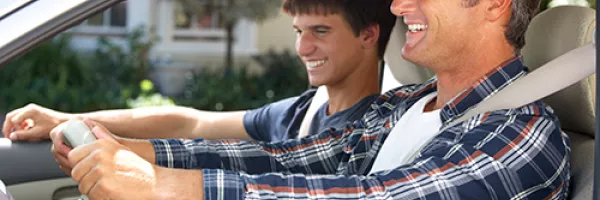
In many ways, the day your teenager comes home with their driver's license is one of the greatest steps they'll take toward independence. Suddenly, they can transport themselves anywhere they want to go--and that's a huge milestone. As a parent, you're understandably concerned about letting go. Thankfully, you have the power to positively influence your child's driving behavior, even when you can't be there to see it.
Experience
Provide plenty of driving experience before letting your teen behind the wheel alone. Even a teenager who seems to take naturally to driving need to have plenty of experience before they get behind the wheel on their own. According to the CDC, you should provide at least thirty to fifty hours of supervised driving time before allowing your child out on the road alone. They also recommend giving your teen plenty of experience in different driving conditions.
It's tempting to only let your permit-holding teen drive under the best of conditions. When it starts raining, instead of having your teen pull over so you can take the wheel, let them experience wet roads. Is your teen having trouble exhibiting safe driving behavior in the rain? That's when it's time for you to take over. Instead of avoiding rainy driving conditions for a while, however, make it a priority to take them out driving the next few times it rains. Even if it means driving around a little-used parking lot for an hour or two before venturing back out on the road, give your teen the experience they need to feel competent behind the wheel when the time comes for them to drive alone.
The same goes for night driving. Driving at night can be very disorienting, especially for a new driver. You might be tempted to simply limit your teenager to driving during daylight hours until they have the chance to become more comfortable, but you don't know when circumstances will arise that will require them to drive after the sun goes down. A practice that runs late, a visit to a friend's house that lasts longer than intended, or a trip out to pick up a few things can quickly become disastrous if your teen hasn't learned night driving skills ahead of time. Instead, make night driving a regular part of their driving experience. If you need to run an errand after the sun goes down, bring your teen along and let them take the wheel. They should learn how to drive at night under controlled circumstances, with you there to help, and that they have that experience for the first time when they're driving alone.
Modeling
Model safe driving behavior. As much as they don't want to admit it, your teenager is watching you, and they'll be prone to the same distractions you are. Guilty of "just glancing" at your cell phone if you get a text message while you're driving? Your teen will be more likely to justify the same behavior. Fiddle with the radio when you should be paying attention to traffic. "Well, Mom does it." It's not a conscious thought on the part of your teen as much as it is an automatic behavior that they likely aren't even thinking about. Do you always wear your seat belt when you're behind the wheel and insist on the proper seat belt use in the car, or are you a little lax with how often you actually remember to put it on? If you always practice car safety, your teenager will be more likely to do it, too.
Teaching Safety
Teach your teen to retain a state of relaxed awareness on the road. One way to do this is by presenting "what if" scenarios as your teen is driving. "What if that car over there were to pull out in front of you?" "What if the car in front of you slammed on its brakes?" "What if that truck tried to change lanes before you were out of the way?" By teaching your teenager to anticipate problems on the road, you help them learn what to do if something does happen--and teach them why it's so important to maintain a safe distance between themselves and other drivers on the road.
Following the Rules
Adhere to your state's Graduated Driver Licensing (GDL) rules. These rules will vary according to state but may include such restrictions as how late at night your teen can drive, how many people are allowed to be in the car with them when they're driving alone, and the hours of driving experience your teen has to have before they can move to the next stage of licensing.
At times, these rules may not seem to make any sense. Why can't your teenager drive alone with his younger brother and sister in the car--or with two of his friends, when all three of them are going to the same destination? It would be easier on all of you if he could just drive himself there! Unfortunately, distracted driving is one of the leading causes of accidents among teenage drivers--and two or three other teenagers in the car is a distraction. So is driving tired, late at night, after he shouldn't be on the road anymore. These restrictions weren't put in place to be an inconvenience; they were put in place to keep your teen, his passengers, and other drivers on the road as safe as possible.
Insistence on safety may get you eye rolls and complaints, but in the end, you don't need your teen's approval--you need to know that they're practicing road safety. As the parent, you're the person in the best place to teach your teen to be a safe driver, and that means that you're the one keeping them from making a decision on the road that could change their lives forever.